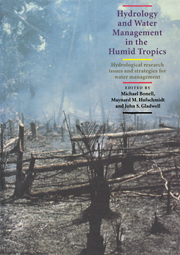 Hydrology and Water Management in the Humid Tropics
Hydrology and Water Management in the Humid Tropics Book contents
- Frontmatter
- Contents
- List of Authors
- Foreword by Federico Mayor, Director-General, UNESCO
- Preface
- Cartographic Credit
- Acknowledgements
- SECTION I INTRODUCTION
- SECTION II HUMID TROPICS SETTING
- SECTION III REGIONAL HYDROLOGY
- 5 Hydrology in Humid Tropical Asia
- 6 The Hydrology and Water Resources of Humid Northern Australia and Papua New Guinea
- 7 Hydrology and Water Resources of Tropical Latin America and the Caribbean
- 8 Amazonia Rainfall and Its Variability
- 9 Regional Hydrology and Water Resources in the African Humid Tropics
- 10 Review of Hydrology and Water Resources of Humid Tropical Islands
- SECTION IV PHYSICAL PROCESSES
- SECTION V PHYSICAL PROCESSES – HUMAN USES: THE INTERFACE
- SECTION VI MANAGEMENT ISSUES
- SECTION VII APPENDICES
- Place index
5 - Hydrology in Humid Tropical Asia
Published online by Cambridge University Press: 23 December 2009
- Frontmatter
- Contents
- List of Authors
- Foreword by Federico Mayor, Director-General, UNESCO
- Preface
- Cartographic Credit
- Acknowledgements
- SECTION I INTRODUCTION
- SECTION II HUMID TROPICS SETTING
- SECTION III REGIONAL HYDROLOGY
- 5 Hydrology in Humid Tropical Asia
- 6 The Hydrology and Water Resources of Humid Northern Australia and Papua New Guinea
- 7 Hydrology and Water Resources of Tropical Latin America and the Caribbean
- 8 Amazonia Rainfall and Its Variability
- 9 Regional Hydrology and Water Resources in the African Humid Tropics
- 10 Review of Hydrology and Water Resources of Humid Tropical Islands
- SECTION IV PHYSICAL PROCESSES
- SECTION V PHYSICAL PROCESSES – HUMAN USES: THE INTERFACE
- SECTION VI MANAGEMENT ISSUES
- SECTION VII APPENDICES
- Place index
Summary
ABSTRACT
A description of rainfall, evaporation and transpiration, climatic water balance, river regimes, deltas, irrigation, groundwater, soil erosion and the hydrological effects of forest conversion are systematically presented for humid tropical Asia. Underlying themes are the implications of the monsoon circulation, e.g. typhoons and the very high population density on the hydrology and water resource management of the region.
INTRODUCTION
The humid tropics can be defined in different ways. The definition adopted by this Colloquium specifies that the humid tropics is that region where the mean temperature of the coldest month is above 18°C and the duration of the wet season exceeds 4.5 months (Chang & Lau, 1983). A wet month is defined as one that has more than 100 mm of rainfall. When the rainfall is between 60 and 100 mm, half a wet month is credited. The humid tropics has three sub-types: (1) “wet” has 9.5 to 12 wet months, (2) “subhumid” has 7 to 9.5 wet months and (3) “wet-dry” has 4.5 to 7 wet months. The total area of the humid tropics is approximately 29.4 million km2, or 22% of the Earth's land area. It is most extensive in the Americas, accounting for 44% of the total, followed by 32% in Africa, 18% in Asia and 6% in Oceania.
The Asian sector includes nearly the entire region of South East Asia – south of the Tropic of Cancer (Fig. 1).
Over the Indian subcontinent, only a narrow strip of the west coast, a belt of the east coast of about 350 km width from southern Bangladesh to the Coromandel coast and Sri Lanka fall within the humid tropics.
- Type
- Chapter
- Information
- Hydrology and Water Management in the Humid TropicsHydrological Research Issues and Strategies for Water Management, pp. 55 - 66Publisher: Cambridge University PressPrint publication year: 1993
- 1
- Cited by


